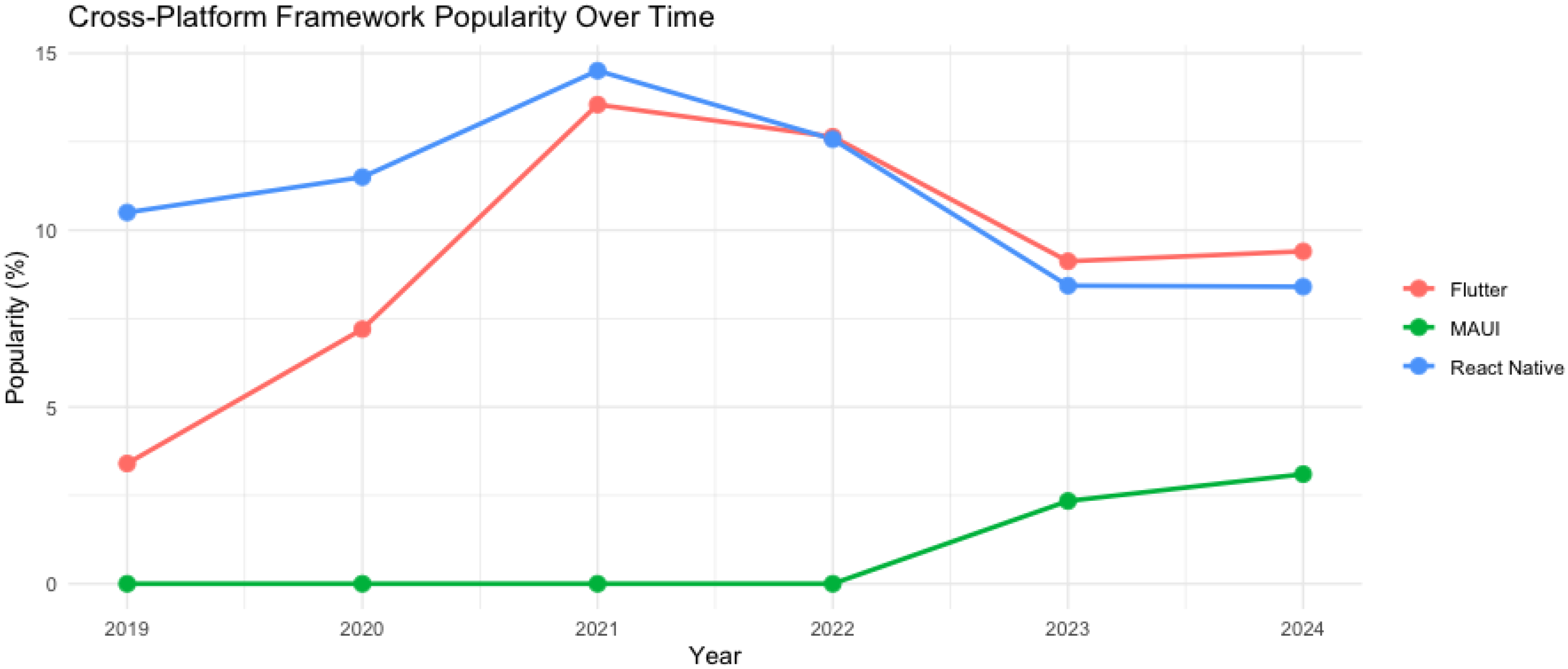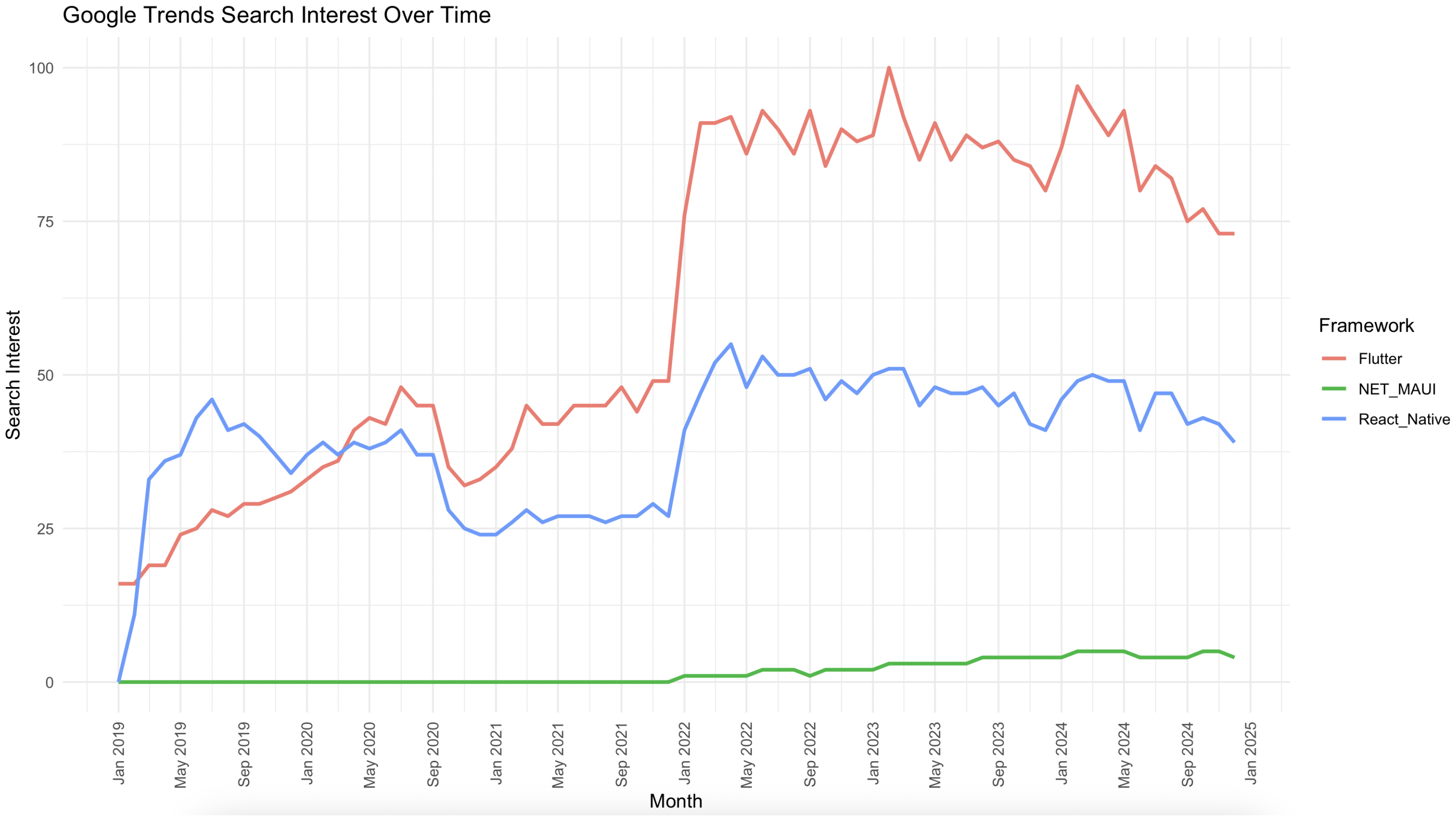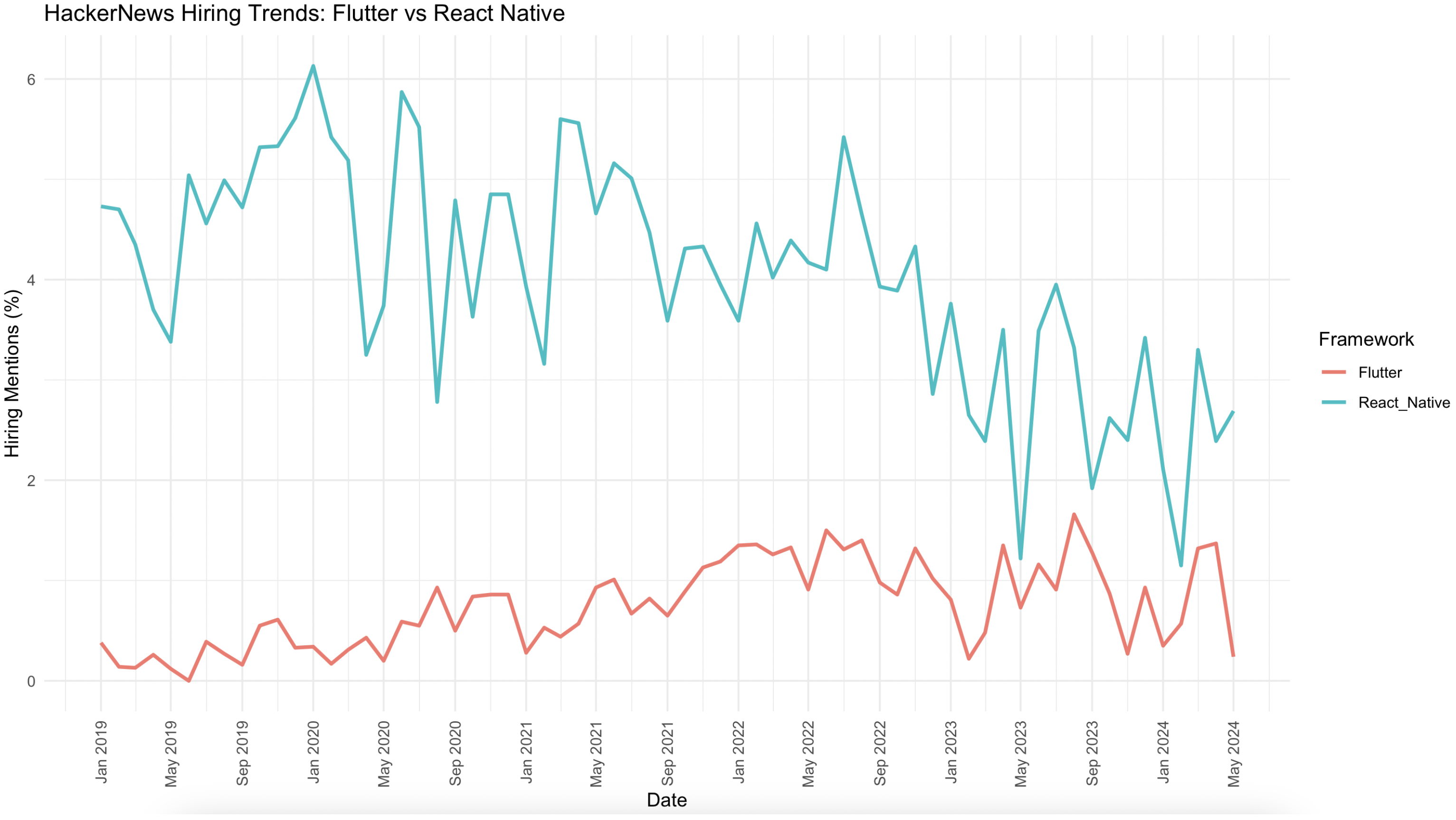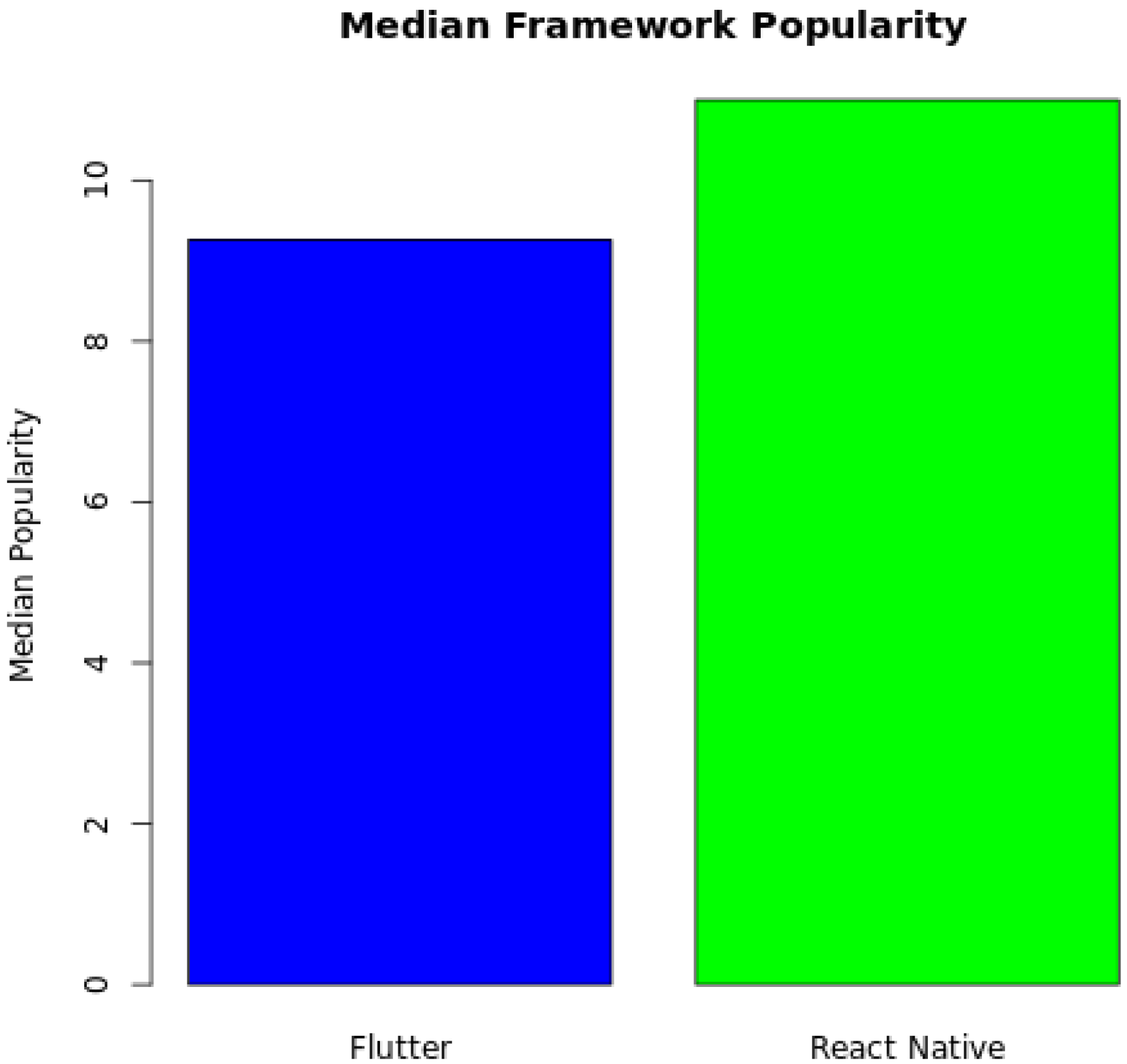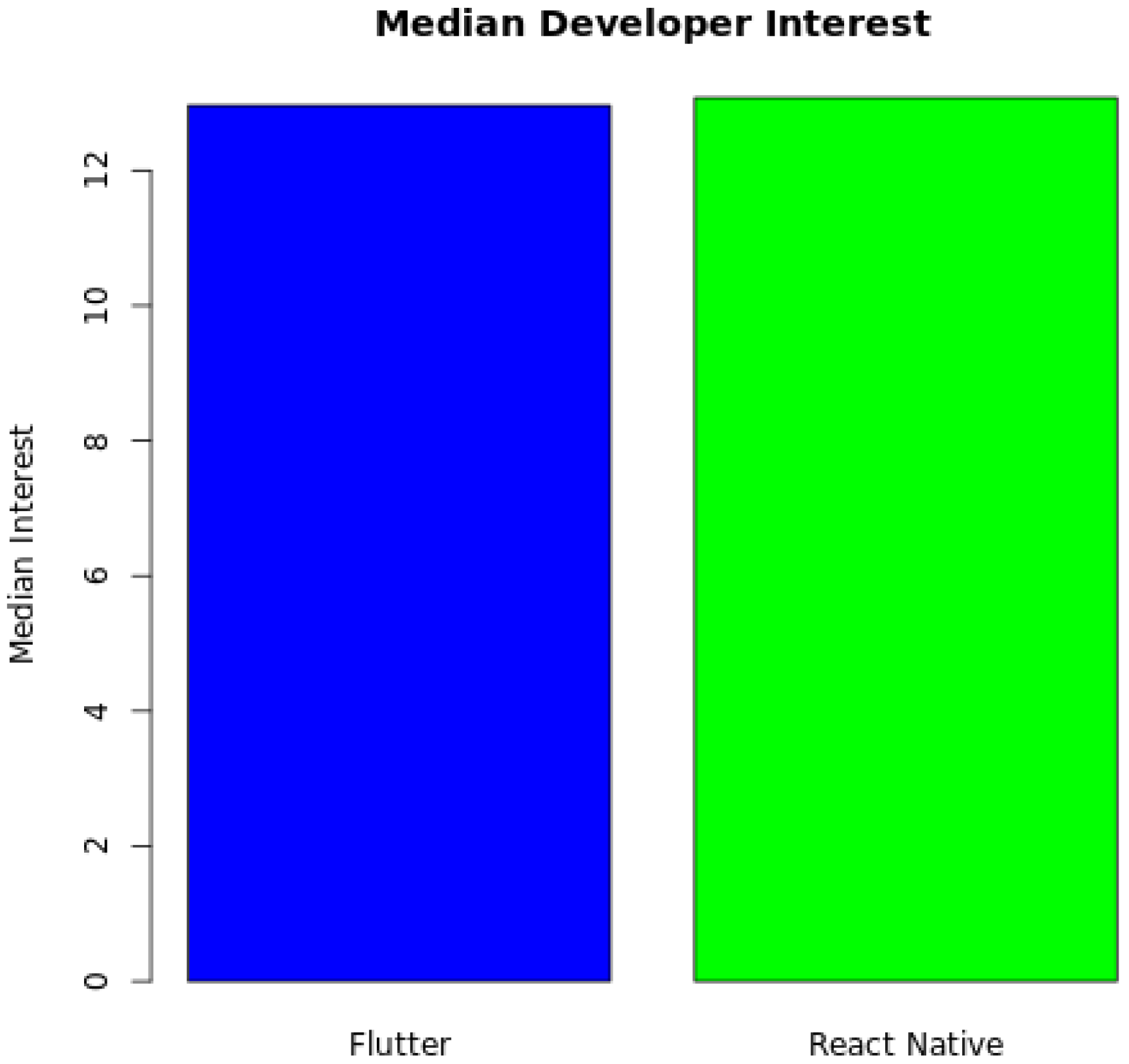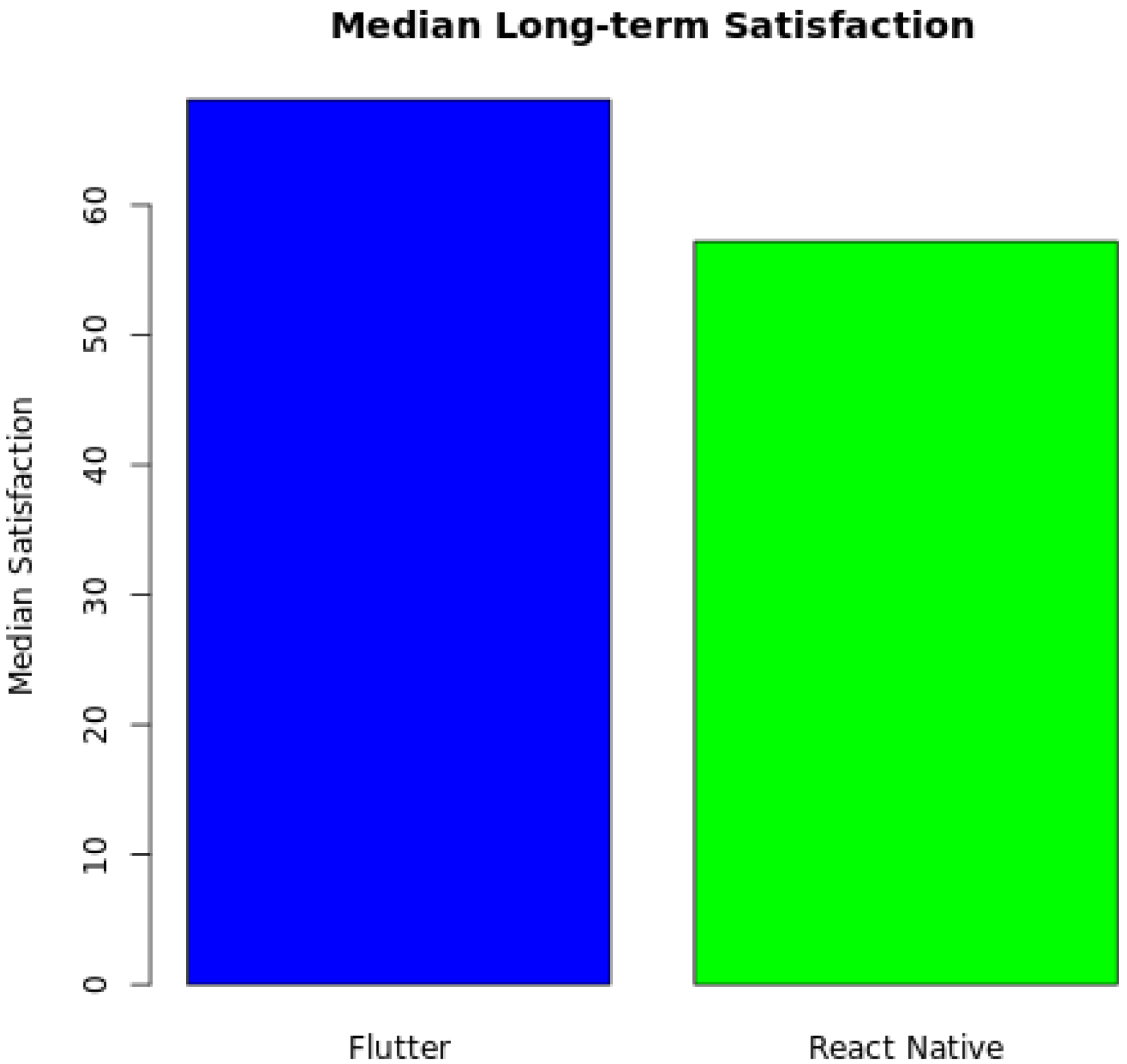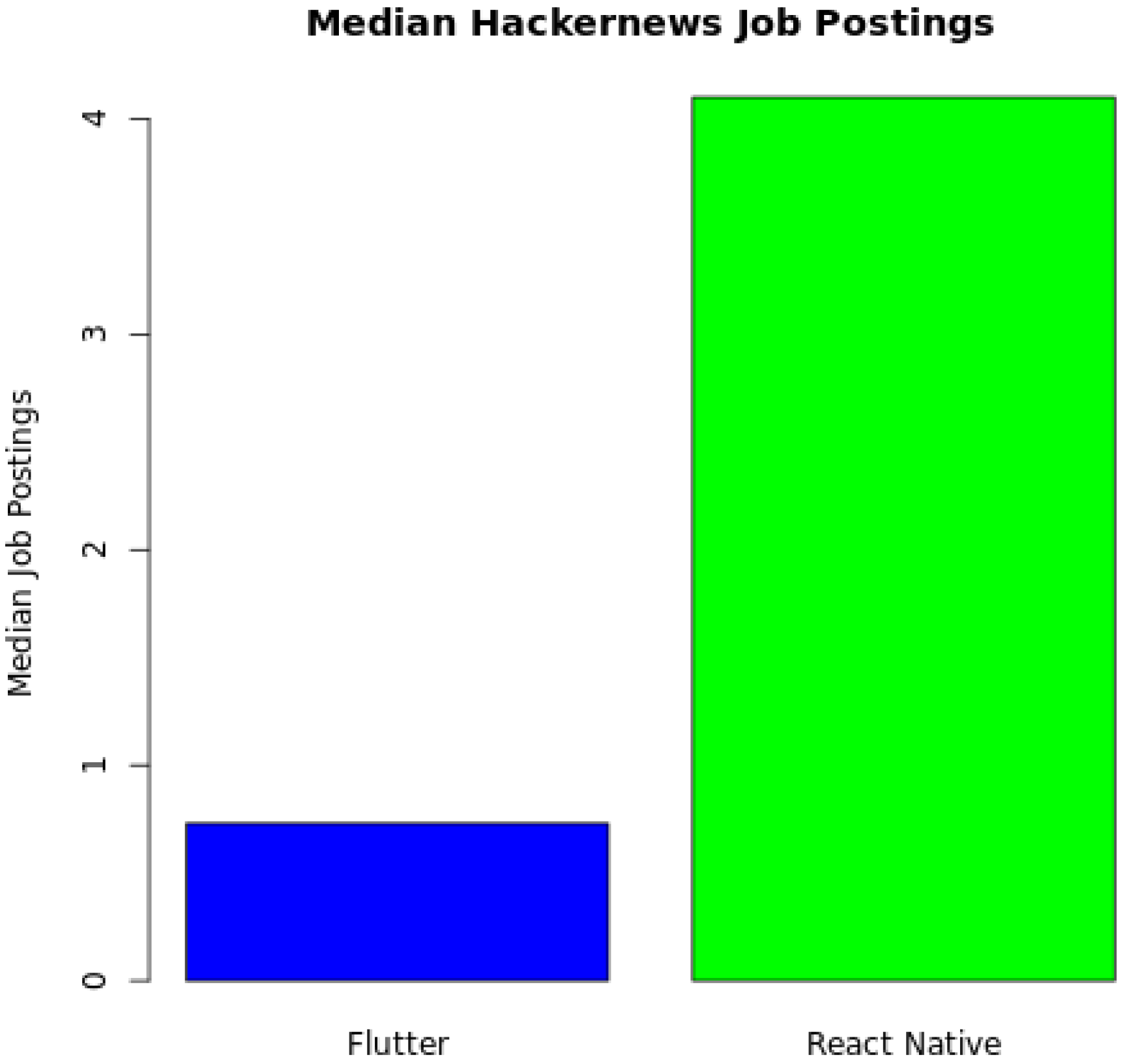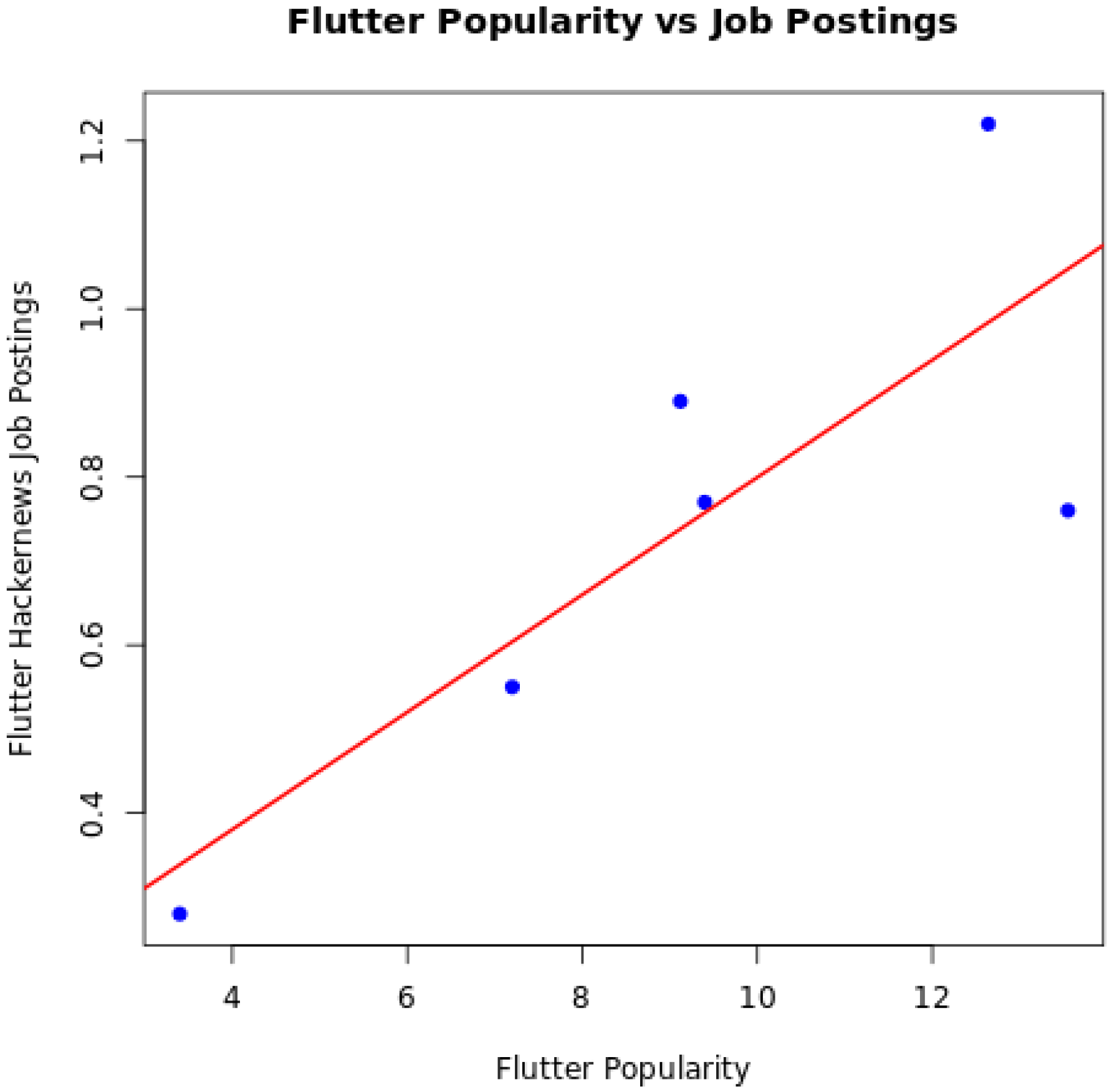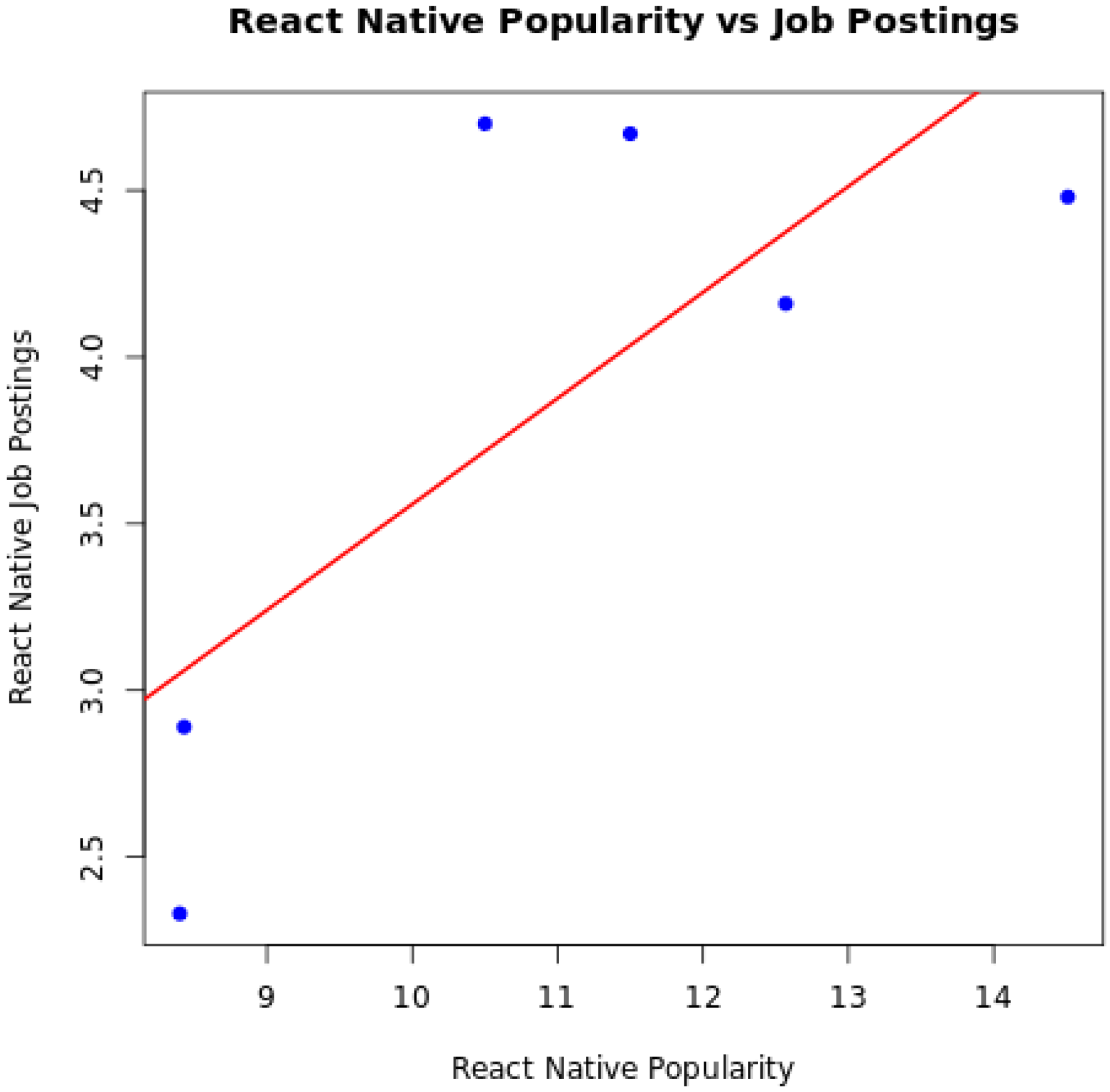In this study, we aimed to assess the differences and potential correlations between various CMADFs, focusing on Flutter and React Native. The data used for analysis span the period from 2019 to 2024.
As our datasets were small, particularly for comparisons between different frameworks (e.g., Flutter and React Native), we utilized the non-parametric Mann–Whitney U test. This test is appropriate for comparing two independent groups when the sample sizes are small and when normality assumptions cannot be reliably met. The Mann–Whitney U test allows for comparisons of medians between groups, making it a suitable choice for comparing metrics such as popularity, developer interest, and long-term satisfaction between the frameworks.
In addition to comparing the datasets between frameworks, we sought to explore whether there was any correlation between the popularity of a framework and the number of job postings associated with it. For this purpose, we used Pearson correlation analysis. This method measures the strength and direction of a linear relationship between two continuous variables. It is particularly useful for assessing how changes in one variable (e.g., popularity of a framework) may be associated with changes in another (e.g., job postings).
The analysis of data collected was conducted using R 4.3.3 in RStudio.
Results and Interpretations
For Research Question 1 (RQ1), we used the Stack Overflow Survey as our primary data source as it offers more detailed insights into framework usage. Furthermore, our focus was on comparing React Native and Flutter, excluding MAUI due to its insufficient sample size (n = 2) as developers did not choose it until 2023. Given the small sample size (n = 6) and the limitations of normality tests, we applied the non-parametric Mann–Whitney U test to compare the popularity, developer interest, and long-term satisfaction metrics between Flutter and React Native.
The H1a hypothesis predicted that there would be a significant difference in popularity between the two most widely used CMADFs, Flutter and React Native. However, the Mann–Whitney U test resulted in a
p-value of 0.59, well above the significance threshold of 0.05. This indicates that the evidence is insufficient to support the claim of a significant difference in popularity. The bar plots of mean framework popularity (
Figure 4) visually illustrate this trend, showing that, while React Native has a higher median value, the difference is not statistically significant.
We performed a similar analysis using the JetBrains survey to further validate this finding. The results revealed a p-value of 0.396, which further reinforces that there is no statistically significant difference in popularity between Flutter and React Native in the dataset.
Furthermore, the H1b hypothesis proposed that there would be a significant difference in developer interest between Flutter and React Native. However, the
p-value of 0.818 suggests that the observed difference in interest among developers, i.e., those who expressed a desire to use the frameworks but had not yet done so, is not statistically significant. This finding is further supported by the bar plots (
Figure 5), which show that the median values for developer interest in both frameworks are very close. Overall, these results align with the earlier findings on popularity, suggesting that developers perceive similar potential in both technologies, thereby reflecting the broader trends in cross-platform mobile application development, where both frameworks are regarded as top contenders.
Finally, for the H1c hypothesis, we anticipated a significant difference in long-term satisfaction between developers using Flutter and React Native. The Mann–Whitney U test produced a
p-value of 0.004, providing strong evidence for a difference in long-term satisfaction. As also noted by the bar plots in
Figure 6, developers reported higher satisfaction with Flutter (median = 68.1) than React Native (median = 57.2). This finding suggests that, for developers committed to long-term use, Flutter may offer advantages such as better performance, an easier learning curve, or a richer toolset. While this result is intriguing, it is essential to consider that long-term satisfaction is subjective and influenced by many factors, such as project requirements, team preferences, and the specific challenges developers face during implementation. The result highlights that, for those developers who are committed to using one of the two frameworks long-term, Flutter seems to offer a more satisfying experience.
A similar trend is observed when considering the Google Trends data. After 2019, Flutter emerged as the predominant framework for online search interest. Although earlier intervals saw React Native with higher initial figures (24.42 for Flutter versus 33.33 for React Native), the subsequent periods revealed a noticeable shift. Flutter’s relative values climb significantly, reaching 88.33 compared to React Native’s 49.08 and 87.92 compared to 46.83. These figures suggest that, over time, Flutter has maintained and increased its visibility and appeal in the developer community, further reinforcing the survey and GitHub findings that point toward a more positive long-term user experience with Flutter.
This quantitative finding is further enriched when viewed alongside GitHub repository metrics. On GitHub, Flutter’s repository demonstrates strong community engagement, with 168,618 stars, the highest among the three frameworks, and 82,816 commits. The high number of closed issues (90,152) suggests an active and dedicated maintenance effort, which may at least partially explain long-term satisfaction with the framework.
However, Flutter also has a significantly higher number of open issues (13,122) than React Native’s 598, indicating a larger backlog that could slow down individual issue resolution. Additionally, its latest release was in October 2023, meaning it has not received an update in nearly two years (as of 2025). In contrast, React Native and MAUI have both seen updates as recently as February 2025. While Flutter’s strong community and extensive issue resolution history contribute to its appeal, these challenges in release cadence and backlog management may also influence developer satisfaction over time.
For Research Question 2 (RQ2) and the H2 hypothesis, which posits that there is a difference in job demand between the most commonly used CMADFs based on job posting data, we explored the variations in job postings for Flutter and React Native on Hacker News. To determine the appropriate statistical test for comparing the two groups, we first assessed the normality of the data using the Shapiro–Wilk test. The results indicated that the Flutter dataset was not normally distributed (W = 0.95, p = 0.016), while the React Native dataset followed a normal distribution (W = 0.98, p = 0.241). Since one of the datasets violated the assumption of normality (p < 0.05 for Flutter), we opted for the non-parametric Mann–Whitney U test, allowing for a robust comparison of the two groups without assuming normality.
The analysis revealed a statistically significant difference between Flutter and React Native, with the React Native job postings having a higher median (4.1) than Flutter (0.73). The
p-value < 0.0001 indicates that the difference in job postings between the two frameworks is statistically significant. This substantial disparity is also clearly evident from the bar plots, which visually underscore the large gap between the two frameworks (
Figure 7).
This finding suggests that React Native is currently more prevalent in job postings on Hacker News than Flutter, reflecting higher demand for developers with React Native expertise in the job market. The higher number of React Native job postings may be due to its longer presence in the market and established adoption across various industries. In contrast, Flutter shows fewer job postings in this context, which could indicate relatively less widespread adoption compared to React Native.
MAUI was not included in the Hacker News analysis due to its absence from job postings on this platform. This absence may reflect the framework’s smaller community or a lower volume of job opportunities at the time of the analysis.
Additionally, we considered the latest LinkedIn data from 23 February 2025, which provide additional perspective on job postings. Flutter had 1835 job postings as of this date, while React Native had 2037. This close disparity in the job postings between the two frameworks indicates that both are similarly represented in the job market on LinkedIn. However, React Native still slightly edges out Flutter in terms of overall opportunities. MAUI had 615 job postings, which is a considerably lower number, supporting its current position as a less commonly adopted framework for cross-platform mobile application development.
Overall, these findings highlight the current job market dynamics, with React Native leading in job postings across both Hacker News and LinkedIn, while Flutter also shows a strong presence. The relatively low number of job postings for MAUI on both platforms suggests that it is still developing traction among developers and employers. As adopting these frameworks evolves, future analyses will be helpful to track how job opportunities shift over time, particularly as MAUI gains more visibility and adoption in the development community.
For Research Question 3 (RQ3), we investigated whether a correlation exists between the popularity of a framework and the number of job postings associated with it. The analysis revealed differing trends for Flutter and React Native, highlighting interesting dynamics in how popularity translates into job market demand. To perform this comparison, we first had to group the Hacker News data by year to ensure that both frameworks’ popularity could be analyzed consistently over time.
For Flutter, the Pearson correlation analysis revealed a significant positive correlation between its popularity and job postings (r(4) = 0.816,
p = 0.048). Since the
p-value is below our 0.05 significance threshold, this finding supports hypothesis H3, which posits that greater popularity of a CMADF is associated with an increase in job postings. This trend may reflect the growing industry adoption of Flutter alongside a rising demand for skilled developers. However, given the small sample size (
n = 6), this relationship should be interpreted with caution. The scatterplot (
Figure 8) visually supports this association, showing a positive linear trend between popularity and job postings.
For React Native, the Pearson correlation coefficient was relatively high (r(4) = 0.752), indicating a positive association between popularity and job postings. However, the
p-value of 0.085 exceeds the 0.05 significance threshold, meaning the correlation is not statistically significant. While the results suggest a possible relationship, the lack of significance indicates that the trend may be less consistent or influenced by external factors. This could reflect fluctuations in job postings due to industry-specific demand, alternative hiring preferences, or market saturation. The corresponding scatterplot (
Figure 9) visually suggests a positive trend, although it does not reach statistical significance.
These findings provide key insights into the evolving job market for CMADFs. Flutter’s job demand appears to scale with its rising popularity, while React Native’s job market may be influenced by additional factors beyond popularity alone. Essentially, while Flutter’s demand seems to scale directly with its growing appeal, React Native’s job postings appear to be influenced by more complex, enduring factors rather than short-term surges in popularity.
Future research could explore additional factors influencing job demand, such as regional differences, industry-specific adoption rates, and long-term hiring trends. Additionally, the growing presence of MAUI, although currently less popular, could introduce new dynamics into the cross-platform mobile application development job market in the coming years.
